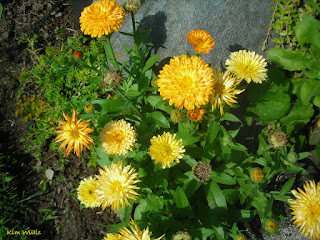 Calendula is a good plant for late spring color in the
garden. It enjoys cool weather and will handle several rounds of frost. Calendula is also an excellent plant to spice
up the late summer and fall garden and will bloom long after the first frost.
Calendula is a good plant for late spring color in the
garden. It enjoys cool weather and will handle several rounds of frost. Calendula is also an excellent plant to spice
up the late summer and fall garden and will bloom long after the first frost.
Calendula is an ancient garden plant and was commonly
known as the marigold or Pot Marigold, and was grown throughout Europe, both as
a medicinal plant and as an ornamental. Then the other type of marigold was
discovered in the New World, the bedding plant that Americans commonly refer to
as the marigold. It was confusing to have two common garden plants with the
same name, so now we use the name marigold for the species Tagetes and
calendula for the wonderful, but almost forgotten, plant formally known as the
marigold.
For a long time the beautiful little calendula has
taken a backseat in ornamental gardens as the other marigold was developed into
hundreds of varieties and sold by the millions in every garden center. As
heritage flowers become popular again, calendula is finally getting some
attention from plant breeders and new varieties that are coming on the market
are sure to spark interest in its use as an ornamental.
How
to grow calendula
Calendula is extremely easy to grow. Most gardeners can
easily grow them from their curved, bumpy looking seeds. The seeds are usually
planted where they are to grow, but they can be started inside. Outside in
spring plant seeds 2-3 weeks before the average last frost in your area. If
planting inside, start them about six weeks before your expected last frost.
Cover the seeds lightly and keep them moist. They bloom quickly from seed,
often as soon as six weeks after planting. You can sometimes find calendula
plants in nurseries in the spring for immediate color. Sowing seed in early July in the garden will
give you beautiful fall flowers as well.
Often spring sown calendulas will go dormant for a bit in warm weather
and then return to bloom in the fall or they will self- sow a second generation
for you.
The calendula flower is daisy-like and 2-4 inches in
size. There are varieties that are double flowered. Calendula flowers seem to glow or shine, in
clear shades of vivid orange and yellow, and they are wonderful in flower
arrangements. For a long time calendulas were always a solid color but recently
plant breeders have introduced varieties with blends of colors and some softer
pastel colors. Calendula flowers open in the day and close at night or in bad
weather
Calendulas need to have the flowers picked off as they
fade, or they will quit blooming. They are an annual plant, but they will
re-seed freely in the garden, and you will get new plants each year if you let
some go to seed. Calendula grows to about 18 inches high and branches freely.
Calendula prefers full sun and average soil moisture. Little or no fertilizer
is needed. They prefer cool weather and tend to go dormant or die in hot humid
weather.
Choosing
Varieties of calendula
Good ornamental varieties of calendula are ‘Citrus
Smoothies‘, very double flowers in pastel blends of apricot and lemon with a
light outer edge, ‘Orange Porcupine’, which has a quilled look to the bright
orange petals, ‘Geisha Girl‘, which is a another deep orange with a very full
look, almost like a small mum, and ‘Neon‘, a deep orange edged in burgundy. The
‘Flashback’ strain has maroon on the back of each flower petal and the front of
the petal is a contrasting color, including peachy pinks. The ‘Pacific Giant’
strain has been around a long time and is a blend of many shades of yellow and orange.
It has some resistance to heat. There are other improved varieties of calendula
and new varieties are coming on the market every year.
Herbal
uses of calendula
Calendula flowers are edible and can be added to salads
for a colorful touch. The petals of calendula have long been used to impart a
golden color to soups, egg dishes, rice, cheese and even butter. Calendula
flowers are fed to chickens to make egg yolks a deeper yellow and to give the
skins of broilers a golden color. (If you use calendula flowers in food make
sure they have not been sprayed with any pesticides.)
Calendula can be used as a tea for stomach upset by
steeping 5 teaspoons of fresh flower petals in hot water. If this mixture is
allowed to cool it makes an excellent mouthwash, especially for sore and
bleeding gums, because of its antiseptic properties. Crushing a calendula
flower on an insect sting will ease the pain. Calendula is used in soothing
salves, foot baths, and facial care products. If you want the variety used for
most commercial herbal preparations look for ‘Erfurter Orange‘.
In short calendulas are an easy annual plant to grow
from seed and give needed color to the garden in colder weather. And not only are they pretty but calendulas
are edible so they fit right into your vegetable or herb garden as well the
flower bed. Make sure to try some in
your garden.

No comments:
Post a Comment